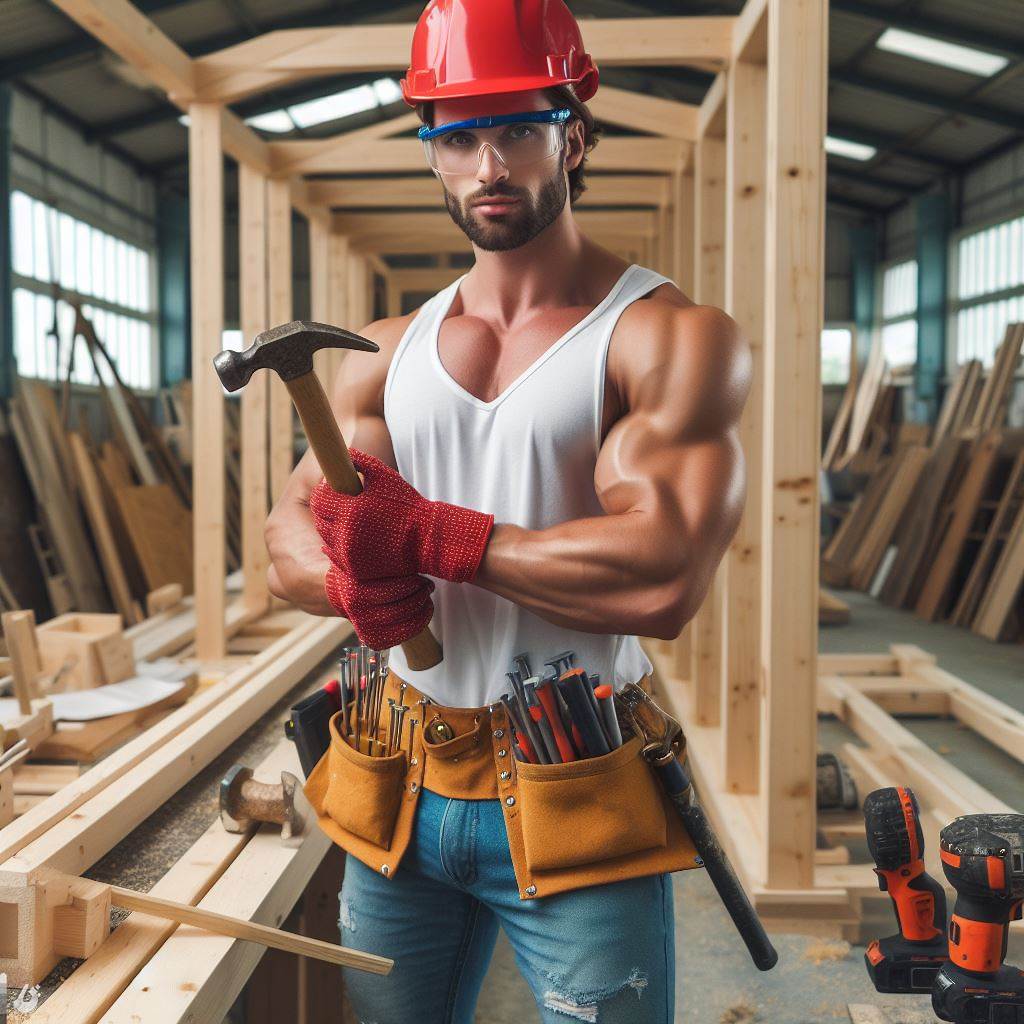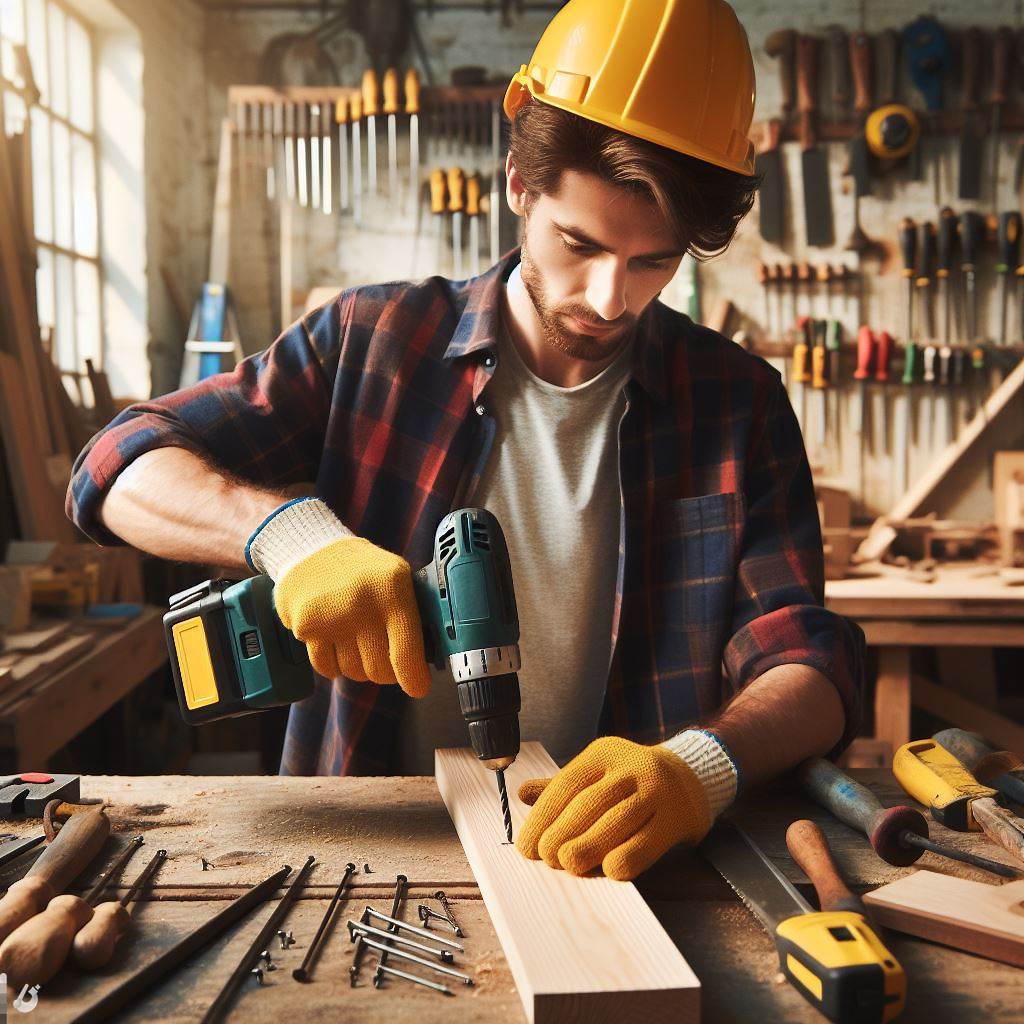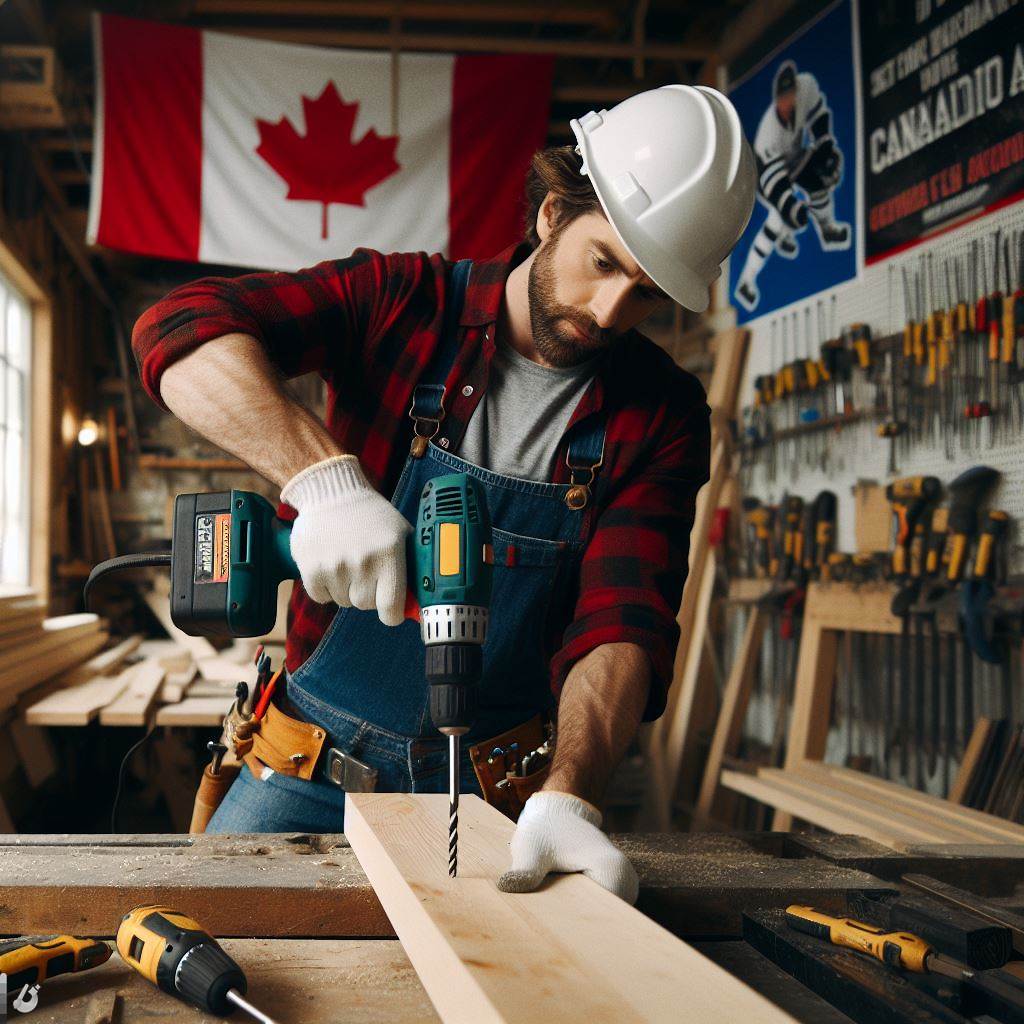Introduction
In the world of Canadian carpentry, having the right tools is crucial for success.
Tools are vital in carpentry as they enable precise measurements, accurate cuts, and efficient work.
The Canadian carpentry industry is thriving, with skilled professionals creating beautiful and functional structures.
Carpenters rely on a variety of tools, from basic ones like hammers and saws, to more specialized ones like routers and jointers.
These tools help carpenters shape and connect wood, transforming it into furniture, cabinets, and buildings.
In addition to hand tools, power tools like drills and circular saws are extensively used to increase productivity.
Canadian carpenters also use measuring tools like tape measures and levels to ensure precise and level work.
Working with wood requires attention to detail, and having the right tools helps carpenters achieve outstanding craftsmanship.
With the advancements in technology, there are now even more innovative tools available to Canadian carpenters.
Investing in high-quality tools is essential for carpenters, as it ensures efficiency, durability, and a professional finish.
Tools play a critical role in the Canadian carpentry industry, allowing professionals to create masterful works of wood craftsmanship.
Basic Tools for Canadian Carpenters
In Canadian carpentry, having the right tools is crucial for any carpenter to complete their work efficiently and effectively.
In this blog post, we will discuss the basic tools that every Canadian carpenter should have in their arsenal, as well as their description and purpose.
We will explore the importance of these tools in the trade and provide tips for selecting and maintaining them.
Description and Purpose of Each Tool
Hammer
A hammer is a handheld tool with a weighted head and a handle, used primarily for driving nails, fitting parts, and breaking objects apart.
Tape measure
This long, flexible ruler-like tool is essential for measuring lengths, widths, and heights accurately, ensuring precision in carpentry projects.
Screwdriver set
A set of screwdrivers, which includes various sizes and types, is used for driving or removing screws to assemble or disassemble wooden components.
Chisels
Chisels are sharp-edged hand tools used for carving or cutting through wood. They come in different sizes and shapes for various carpentry tasks.
Hand saw
A strong and versatile saw with a handle, used for cutting through wood in different directions, making it a staple tool in carpentry.
Level
A level is a tool used to ensure that surfaces, such as floors and walls, are perfectly horizontal or vertical. It helps in achieving accurate alignments.
Importance of Having these Tools in the Trade
These basic tools are the backbone of any Canadian carpenter’s trade. They enable carpenters to measure, cut, shape, and assemble wooden components with precision.
Without these tools, carpentry work would be challenging and prone to errors, compromising the quality of the final product.
A hammer is essential for driving nails, allowing carpenters to join pieces of wood securely.
A tape measure ensures accurate measurements, resulting in precise cuts and fittings. Screwdriver sets enable carpenters to assemble or disassemble wooden parts effortlessly.
Chisels allow carpenters to shape and carve wood, creating intricate designs.
Unlock Your Career Potential
Visualize a clear path to success with our tailored Career Consulting service. Personalized insights in just 1-3 days.
Get StartedHand saws are versatile tools that provide accuracy in cutting various angles and directions.
A level ensures straight and even surfaces, enhancing the overall quality and aesthetics of carpentry projects.
Tips for Selecting and Maintaining Basic Tools
While selecting basic tools, consider their quality, durability, and usefulness for your specific carpentry needs.
Choose tools made from high-quality materials and with ergonomic handles for comfortable use.
To maintain these tools, always keep them clean and dry. Regularly inspect handles and grips for signs of wear and tear, replacing them if necessary.
Keep blades sharp and lubricate moving parts of tools as recommended by the manufacturer.
Properly store tools in a well-organized toolbox or storage system to prevent damage and ensure easy accessibility.
Additionally, protect your tools from extreme temperatures and harsh conditions that can affect their performance and longevity.
In fact, having the right tools is essential for Canadian carpenters to carry out their work effectively and efficiently.
The hammer, tape measure, screwdriver set, chisels, hand saw, and level are some of the basic tools that every carpenter should have.
These tools allow for accurate measurements, precise cutting and fitting, and overall quality in carpentry projects.
By selecting and maintaining these tools properly, carpenters can maximize their longevity and ensure the success of their work.
Read: How to Become a Carpenter in Canada
Power Tools for Canadian Carpenters
Description and Purpose of Each Power Tool
- Circular Saw: A versatile tool used for making straight cuts in various materials.
- Jigsaw: Ideal for cutting intricate shapes and curves in wood, plastic, or metal.
- Power Drill: Essential for drilling holes and driving screws with precision and speed.
- Air Compressor and Nail Gun: Powerful duo for quickly and securely fastening materials together.
Advantages and Efficiencies of Power Tools
Power tools offer numerous advantages over traditional hand tools, including:
- Increased Speed: Power tools perform tasks much faster than manual methods, saving time on projects.
- Enhanced Precision: These tools ensure greater accuracy, resulting in more professional-looking results.
- Reduced Physical Strain: With power tools, carpenters experience less fatigue and strain on their bodies.
- Increased Efficiency: The speed and precision of power tools contribute to higher productivity levels.
- Versatility: Power tools are designed to handle a wide range of carpentry tasks, making them versatile companions.
Considerations When Buying and Operating Power Tools
Before purchasing and using power tools, it’s important to consider the following:
- Quality: Invest in high-quality tools from reputable brands to ensure durability and performance.
- Safety Features: Look for built-in safety features like blade guards and trigger locks to prevent accidents.
- Maintenance: Regularly clean, lubricate, and inspect your power tools to prolong their lifespan.
- Training: Proper training and understanding of the tool’s instructions will prevent misuse and accidents.
- Power Source: Determine whether you prefer corded or cordless tools based on your specific needs.
In essence, power tools are invaluable assets for Canadian carpenters, offering speed, precision, and versatility in their work.
However, it’s crucial to prioritize safety, invest in quality tools, and maintain them properly to ensure optimal performance and durability.
Read: Carpentry in Canada: A Career Overview
Specialty Tools in Canadian Carpentry
Description and Purpose of Each Specialty Tool
A coping saw is a small hand saw used for intricate cutting and shaping in woodworking projects.
A block plane is a versatile tool used for smoothing and shaping wood surfaces, especially for chamfering and planing end grains.
A miter saw, also known as a chop saw, is used for making accurate crosscuts and miter cuts in wood, typically at a fixed angle.
A router is a power tool used for hollowing out an area or shaping edges of wood pieces, creating decorative patterns or grooves.
A moisture meter is a device used to measure the moisture content in wood, essential for preventing issues like warping, swelling, or cracking.
Applications and Benefits of Using Specialty Tools
Specialty tools in Canadian carpentry play significant roles in various applications and offer numerous benefits.
The coping saw allows precise and intricate cutting, making it a valuable tool for creating detailed designs and joints.
Block planes are excellent for quickly removing wood material, achieving smooth surfaces, and creating precise angles on projects.
Miter saws are indispensable for making accurate and clean crosscuts, bevel cuts, and compound angle cuts, ensuring precise joinery.
Routers provide the ability to add decorative details, joints, or shaping to wood pieces, enhancing the overall aesthetics of projects.
Moisture meters help prevent wood-related issues by ensuring wood is properly dried and suitable for the desired application.
Recommendations for Selecting and Utilizing Specialty Tools
When selecting specialty tools for Canadian carpentry, consider the following recommendations:
- Choose high-quality tools from reputable brands to ensure durability and reliability.
- Consider the specific needs of your projects and select tools that offer the required functionality.
- Research and read reviews to gain insights into the performance and suitability of the chosen tools.
- Seek advice from experienced carpenters or professionals to understand the best options for your specific projects.
- Invest in proper maintenance and storage solutions to prolong the lifespan of your specialty tools.
When utilizing specialty tools, adhere to the following practices:
- Follow manufacturer instructions and safety guidelines to avoid accidents and maximize tool performance.
- Regularly inspect tools for any damages or defects, and promptly repair or replace them as necessary.
- Ensure proper training or acquire necessary skills to safely and effectively use each specialty tool.
- Keep tools clean and well-maintained to ensure optimal functionality and longevity.
- Store tools in a safe and organized manner, protecting them from damage or misuse.
By carefully selecting and utilizing specialty tools, Canadian carpenters can enhance their craftsmanship and achieve outstanding results in their projects.
Read: Building a Plumbing Business in Canada: Tips

Safety Equipment for Canadian Carpenters
Importance of Prioritizing Safety in Carpentry Work
When it comes to carpentry work, prioritizing safety should be the topmost concern for Canadian carpenters.
The nature of this profession involves working with various tools and equipment that can pose potential hazards if not handled properly.
Having the right safety equipment is imperative to ensure a safe working environment.
Essential Safety Equipment for Carpenters
Safety Glasses
Protecting the eyes is crucial in carpentry. Safety glasses shield the eyes from flying debris, wood chips, or any other particles that may cause injury.
Dust Mask
Carpenters often work with materials that generate dust, such as wood, sawdust, or paint particles.
Wearing a dust mask helps prevent inhalation of harmful substances and protects against respiratory issues.
Ear Protection
Exposure to loud noises from power tools can lead to hearing damage. Ear protection, such as earmuffs or earplugs, should be worn to safeguard against potential hearing loss.
Gloves
Carpentry involves handling sharp objects, heavy materials, and operating machinery.
Wearing gloves provides hand protection from cuts, abrasions, and splinters.
Steel-toe Boots
Since carpentry often involves working with heavy materials and tools, sturdy footwear is essential.
Steel-toe boots offer foot protection from falling objects, punctures, and potential crushing hazards.
First Aid Kit
Accidents can happen even when using safety equipment. Having a well-stocked first aid kit on-site is crucial for immediate treatment of injuries until professional help arrives.
Ensuring Proper Use and Maintenance of Safety Equipment
It is not enough to just have the necessary safety equipment; carpenters must ensure their proper use and maintenance to maximize their effectiveness.
Here are some guidelines:
Regular Inspection
Inspect all safety equipment regularly to identify any damage or wear and tear. Replace or repair them as needed to maintain their effectiveness.
Proper Fit
Ensure that safety glasses, gloves, and ear protection fit properly. Ill-fitting equipment may not provide adequate protection and can hinder performance.
Training
Provide proper training to carpenters on how to use safety equipment correctly. They should understand its purpose, how to wear it, and when it is necessary.
Replacement
Replace safety equipment that has been damaged or shows signs of wear immediately. Using faulty equipment can compromise safety.
Cleanliness
Regularly clean safety glasses, dust masks, and gloves to remove dirt, debris, or chemicals that can impair their functionality.
Storage
Properly store safety equipment in designated areas to prevent damage and ensure easy accessibility when needed.
In a nutshell, safety equipment plays a vital role in the lives of Canadian carpenters.
It not only protects them from potential injuries but also reinforces their confidence to work efficiently and effectively.
Prioritizing safety by using and maintaining the correct safety equipment is essential for a successful and secure carpentry career.
Read: Common Plumbing Myths: Canadian Edition
Conclusion
Tools play a significant role in Canadian carpentry, aiding craftsmen in their daily tasks.
The importance of selecting quality tools cannot be overstated as they contribute to better craftsmanship, efficiency, and durability.
It is crucial for carpenters to invest in high-quality tools that can withstand rigorous use and produce precise results.
Continuous learning and skill enhancement in using these tools are essential. In an ever-evolving industry, carpenters must stay updated with new techniques and innovations in tool technology.
By attending workshops or courses and keeping up with industry publications, craftsmen can improve their abilities and adapt to new tools and methods.
Moreover, a carpenter’s efficiency and productivity are directly impacted by their proficiency with tools.
Regular practice and experimentation with various tools help carpenters become more adept at using them, enabling them to complete projects more efficiently.
By continuously enhancing their skills, carpenters can achieve greater precision and finesse in their work, resulting in higher customer satisfaction..
Reliable tools minimize the risk of accidents and injuries, eliminating hazards associated with faulty equipment.
Carpenters should always prioritize safety and invest in tools that comply with industry standards.
The significance of tools in Canadian carpentry cannot be emphasized enough.
Quality tools improve craftsmanship, enhance efficiency, and promote safety.
Carpenters should strive for continuous learning and skill enhancement, embracing new tools and techniques to stay competitive in the industry.




